From Jerusalem, I took the bus north to Tiberias, which I used as a base for touring the Galilee. From Tiberias, I took a bus to the scenic mountain village of Tsfat, which is famous for Kabbalah and Jewish mysticism.
I had lunch in a restaurant in Tsfat’s Artists’ Quarter that consisted of a sandwich of Tsfat cheese and rocket sprouts. As I munched my lunchtime sandwich, I gazed out over the valley before me, and at Mt. Meron. Amirim, which was to be my next destination, was directly ahead of me, just on the other side of Mt. Meron’s lower slopes.
Amirim is a vegetarian commune, or kibbutz, and home to a number of holistic and alternative healthcare practitioners. One of them, an herbal medicine woman named Orit Baruch, had contacted me via my website. Orit’s email address is: olivemedicine@gmail.com .
Orit had been seeking to further her studies in traditional medicine when she came across my website. Although Israel boasts many fine schools of acupuncture, Chinese Medicine and Ayurveda, these systems, she told me, were not her way.
Orit was more interested in the Greco-Arabic system of medicine, which is the true indigenous traditional healing system of the Holy Land. To this end, she had done field research visiting local Arab sheikhs who were knowledgeable about the healing herbs of the region and their medicinal uses.
The bus let me off right across the highway from the entrance to Amirim. As I walked into the community, many cozy country cottages greeted me, boasting vegetarian bed and breakfast accommodations. Stepping into Amirim was a bit like stepping back into a hippie world, reminiscent of California in the 60’s.
Before long, someone who looked like an organic farmer or gardener came by in his pickup truck to give me a lift. To my surprise, it turned out that he knew Orit, and took me right to her clinic, which was nestled amidst Rosemary bushes and Olive trees. Orit greeted me with a warm smile and invited me in for a cup of herb tea.
“A terrible thing has happened,” Orit told me.
“Omar Said has been put in prison by the Israelis.”
Omar Said , she told me, was one of the greatest herbalists in Israel, and in the whole world. He was also the founder of an herb company named, coincidentally, Al Antaki. And, although there were certain rumors and suspicions floating around as to the Israeli government’s motives for his imprisonment, no one was sure exactly why.
Furthermore, and rather synchronistically, Omar’s imprisonment by the Israelis seemed to coincide precisely with my arrival in the Holy Land at the end of April. Could it be, Orit wondered, that somehow my arrival in the Holy Land was meant to compensate for the untimely loss of Omar Said? Only time will tell.
Omar was a great herbalist, Orit told me, perhaps one of the greatest in the world. But Omar Said didn’t get too much into the classical theories of the Greco-Arabic medicine of the region, such as the Four Humors, Orit said. His approach was more focused on the herbs and their traditional uses, gleaned from local folk healers as a field researcher and ethnographer. And he backed up the information and leads he got from the local folk healers regarding the herbs with the latest scientific research, often pioneering groundbreaking research of his own.
The way I see it, there are three main ways in which the study and practice of herbal medicine can be furthered:
1) By following a model that is strictly based on the classical precepts of a traditional medical system like Unani Tibb, or Greco-Arabic Medicine;
2) By doing field research on the traditional folk medical uses of the herbs from local folk healers;
3) By using modern scientific methods to test, research and verify the medicinal and therapeutic properties of herbs.
Mohammad, at his clinic in Nablus, was primarily following the first approach of returning to the classical humoral precepts of the traditional Greco-Arabic medicine of the region. Omar was using the last two approaches – field research into the folk medicine uses of the herbs, backed up by scientific research.
Ideally, what is needed is a synthesis of all three approaches – the traditional, the ethnographic and the scientific. And the best way to accomplish this would be for herbalists from all over the Holy Land, both from Israel and Palestine, to come together for the advancement of herbal medicine.
Orit called one of her herbal friends, Egal Ben Yitzak, over to visit, and to have a cup of herb tea with us. Egal worked for a local herb company and manufacturer of herbal products. Over a soothing cup of tea, we talked about herbs, politics and the imprisonment of Omar.
Both Orit and Egal, I learned, collected their own herbs, and spent hours on the slopes of Mt. Meron and in other rustic locations throughout the Galilee, gathering up herbs in their handbaskets. Egal told me that certain herbs like Milk Thistle (Silybum marianum) were so plentiful in northern Israel that there were vast fields of them, seemingly endless. My own experience hiking in the hills of Israel and Palestine showed me that there was definitely no shortage of thorns and thistles, and thistles of almost every description. Other herbs, like Wild Carrot, or Queen Anne’s Lace (Daucus carota), which also grew in great profusion throughout the countryside, were already familiar to me from my travels in Romania.
It was clear to see that Orit and Egal both loved the land, and all of God’s herbs that grew upon it. Orit said that there was no place that she would rather live than at Amirim.
“The spiritual vibrations of this place are very pure”, Orit assured me. “That’s because nobody has ever lived here, or wanted to live here, before this vegetarian community was established here at Amirim. It hasn’t ever been fought over, or bitterly contested.”
That night, Orit, Egal and I went out to explore the land, and to eat dinner. At sunset, they took me to a spectacular lookout point at Amirim from whence I could get a sweeping panoramic view of all of the Galilee. Incredibly inspired by the wondrous beauty of it all, I pulled out my pan flute and began to play.
“See that small tree or bush down there?”, Egal said, pointing. The bright, electric green leaves of the tree were radiating vitality and life.
“What is it?”, I asked.
“It’s the Mastic tree.”
“You mean Pistachia lentiscus, the tree they get Mastic gum from?”
“Yes, that’s it. Now taste the leaves.”
The leaves tasted incredibly fresh, tangy and zesty.
“Before he was imprisoned, Omar Said was conducting groundbreaking original scientific research on the antimicrobial properties of Mastic leaves, and their ability to disinfect and boost the immunity of the liver in liver diseases like hepatitis. But his imprisonment put an end to all that.”
“What a shame!” I replied. “I’m sure that he was on the verge of a great healing breakthrough in herbal medicine.”
Egal then pointed out some Milk Thistle (Silybum marianum) plants to me. This humble and homely thistle is nevertheless without equal in its ability to regenerate liver cells as a hepatoprotector. And Egal wqas right; I did see vast fields of these thistles in my travels throughout the Holy Land.
Egal was truly like a walking encyclopedia when it cme to the local herbs. As we drove along, Egal, our driver, was constantly making stops along the way to point out this or that medicinal herb. His love and enthusiasm for herbs were truly contagious.
One thing that really amazed me on my herbal tour of the Holy Land was how many different varieties of composite family plants that God has blessed this land with. These included diverse species and subspecies of Mints, Sages, Thymes and Oreganos.
Native Healing Wisdom – Learning from the Elders
The following Monday evening, at a posh health resort hotel in the upper Galilee near Tsfat, Orit gave a lecture, which Egal and I attended, on the Native American Medicine teachings. Orit had traveled to Calgary in Western Canada to apprentice under a Native American shaman or medicine man named Willie, who was from theCree tribe. She also spoke about their healing herbs.
Back in my own country, the United States, in the 19th century, herbal medicine enjoyed a great renaissance of popularity, progress and advancement due to two great schools of herbal healing, the Eclectics, and the Thomsonians, also known as Physiomedicalism. Both schools of herbal medicine took their inspiration from Native American herbal healing traditions. The Eclectics were great pioneers in the scientific study of herbs.
The lesson of all this is clear: Herbal medicine flourishes and progresses when the healing ways of the native or indigenous peoples are honored and respected, and their elders are listened to and learned from in a state of humility and receptivity. Conversely, destruction of the native or indigenous peoples and their traditions will result in the loss of their precious herbal healing wisdom, to the detriment of all mankind.
It could be argued that, in ancient times, the Jewish people could have been called native or indigenous peoples in their old homeland, the Holy Land. But during their long diaspora, they lost touch with the land and its healing herbs. In the nearly two millennia between the banishment of the Jewish people from the Holy Land at the hands of the Romans, and their return to the Holy Land in 1948, the Arabs and Palestinians who populated the land in the interim have become the indigenous people of the Holy Land, and the custodians of its herbal healing wisdom.
I don’t pretend to know what the true purpose and agenda of the Israeli government is when it comes to herbal medicine and natural healing. But if they are sincerely interested in the progress and advancement of herbal medicine in the Holy Land, it would behoove them to respect and honor the indigenous peoples, the Arabs and Palestinians, and learn from their herbal healing traditions.
The Hanging Gardens of Haifa
I ended my trip with a brief stay in Haifa. There, the main attraction is the Baha’i Gardens, which are laid out, in a terraced format, on the slopes of Mount Carmel, overlooking Haifa’s magnificent bay and harbor. I leave you with pictures of them below.





